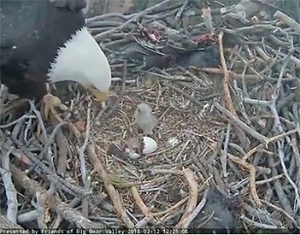 With all eyes glued to a live streaming “nest cam,” viewers from all over the country watched as two bald eagle chicks within two days of each other began to pip—that is, to crack the shells of their respective eggs and work their ways out into their parents’ nest in San Bernardino National Forest near Big Bear Lake.
With all eyes glued to a live streaming “nest cam,” viewers from all over the country watched as two bald eagle chicks within two days of each other began to pip—that is, to crack the shells of their respective eggs and work their ways out into their parents’ nest in San Bernardino National Forest near Big Bear Lake.
The first chick made its way into the world at approximately 9:57 a.m. on the morning of February 11, 2018. The second chick hatched at approximately 12:20 p.m. February 12.
Two eggs were laid in early January in the nest of a pair of eagles. The pair took turns on the nest during the 35 day incubation period, including through a snow storm. The second egg was laid three days later than the first.
In November 2016, the nonprofit Friends of Big Bear Valley, with the support of San Bernardino National Forest, installed a live-stream camera near the nest. The livestream can be viewed at http://www.iws.org/livecams.html (Select “Big Bear Eagle Cam, Big Bear Lake). The camera allows viewers to watch the nest action up close and personal without causing any disturbance that might result in the eagles abandoning the chicks.
The parents are a newly identified nesting pair. U.S. Forest Service biologists believe that the female hatched from this nesting area in February 2012 and that she now occupies her natal territory after it was abandoned in 2017. On the live-stream camera, she can be distinguished from the male by a few black-tinged tail feathers. By next year, when she has gained her full adult plumage, those feathers will be all white. She is also larger than the male, a size distinction common in most raptors.
Both parents share in incubation and parenting duties. If all goes well, the chicks will leave the nest in two and a half to three months. They’ll stay close to their parents while they hone their hunting skills. Until then, the parents will continue to help provide food.
This Big Bear nesting territory has produced four eagles since the first successful nesting occurred early in 2012. To protect the eagles from disturbances which could affect young survival, the area surrounding the nest is completely closed to all public entry.
Meanwhile, in the hours before the pipping began, 214 people helped biologists from San Bernardino National Forest and California State Parks count wintering bald eagles as part of an annual event that takes place over four Saturday mornings every winter at six Inland Empire lakes. A total of 11 bald eagles, seven adults and four subadults, were confirmed. A possible 12th eagle may have been spotted, but was unconfirmed. The results are as follows:
Big Bear Lake: Two adults, who are the parents to the eggs on the webcam, and one subadult were spotted by 114 participants. A second subadult was possibly seen, but was unconfirmed by biologists.
Lake Arrowhead and Lake Gregory: Two adults and one subadult spotted by 26 participants at Lake Arrowhead. None were spotted at Lake Gregory by two participants there.
Silverwood Lake: One subadult spotted by 25 participants.
Lake Perris: One adult spotted by 33 participants.
Lake Hemet: Two adults spotted by 14 participants.
The public is invited to help Forest Service and California State Park biologists at the remaining winter bald eagle count on Saturday, March 10. The events are held at six Inland Empire lakes, including Big Bear Lake.
Photo courtesy of Friends of Big Bear Valley
